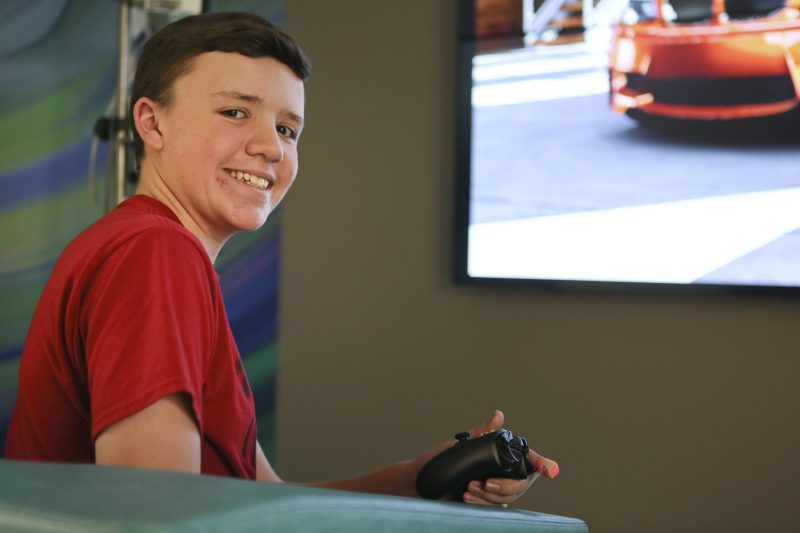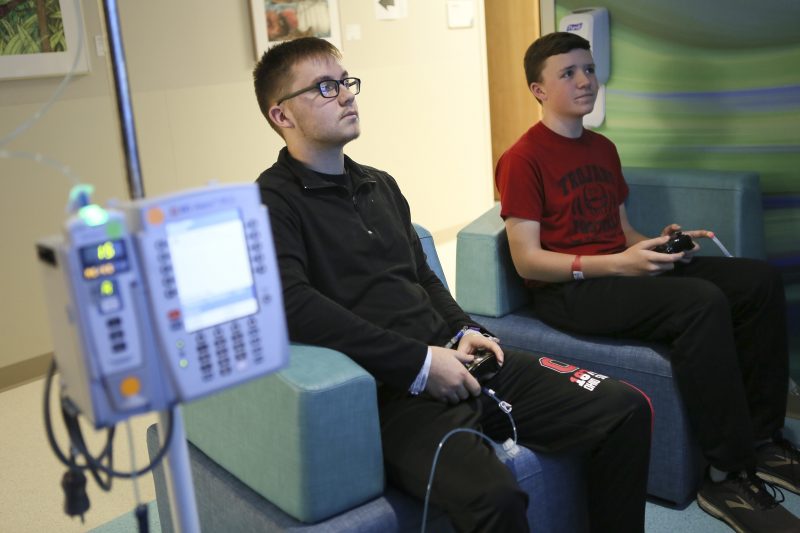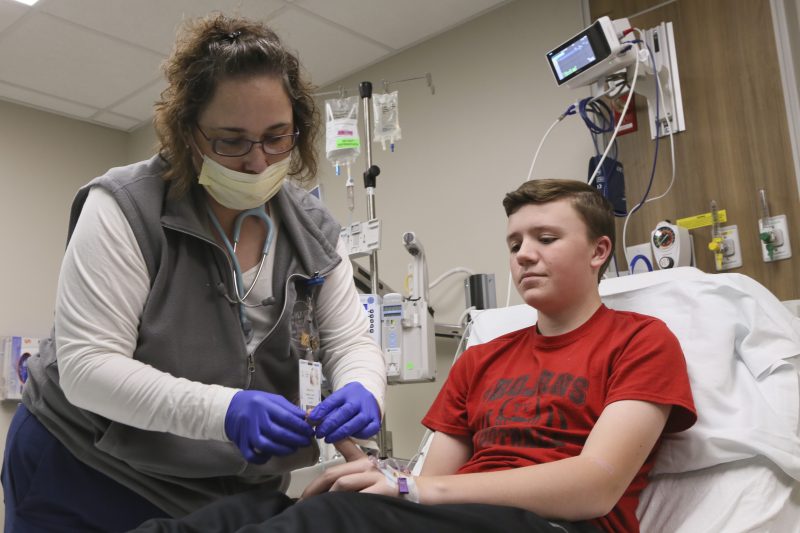Extra Life Raises Money for Patients in New Infusion & Sedation Center

Colton plays video games as he gets an infusion in the new center for outpatients.
During a recent visit in our new Infusion and Sedation Center, 13-year-old Colton settled in front of a large video wall to play a car racing game. For kids like Colton, video games are a welcome distraction while they’re receiving infusions, which usually take several hours to complete.
The new play zone, which features the video wall, is just one of many amenities incorporated into the design of the Infusion and Sedation Center to enhance patient experience.
“On average, most infusions take about three to four hours, but some can take as long as eight to 10 hours,” said Melissa Williams, nurse manager for the Infusion and Sedation Center. “We’ve also provided an Xbox and television in every patient room. Because the infusion pumps are portable, children can easily leave their rooms to go to the play zone.”
The Xbox consoles and video wall were donated by Extra Life, an organization that unites gamers around the world in support of their local Children’s Miracle Network Hospital.

Patients can play video games in their rooms or with each other in a common area with a big video wall in the new Infusion and Sedation Center.
The new Infusion and Sedation Center opened in October on the first floor of the main hospital building on our Akron campus. For the first time, our sedation service has dedicated space. Dr. Troy Sands serves as director of Pediatric Sedation Services, while Dr. Corrie Stofcho is the director of Pediatric Infusion Services.
“When the sedation service line was developed 10 years ago, it had a secretary and 2 nurses. Since then, it has grown to have an office coordinator and 14 nurses and is run by the hospitalists,” said Melissa. “Previously, sedations were performed at various locations throughout the hospital as space allowed or in the departments that requested the sedations, but this was not efficient. It was often challenging for patient families and procedure teams to know where we were performing sedations on any given day.”
The center’s close proximity to our Radiology Department is also ideal for patients who need sedation before imaging procedures.

At Akron Children’s, 60% of our sedations are for radiology procedures, especially for young children up to age 5-7 years who can’t stay still during their procedure. The other 40% are for invasive and painful procedures, such as spinal taps, bone marrow aspirations, dental procedures, or removal of sutures or stitches. Sedation may also be used with brainstem-evoked response hearing tests in children who are very young and developmentally or behaviorally unable to complete other hearing tests.
The Infusion and Sedation Center features 2 large procedure rooms that can easily accommodate our sedation and procedure teams, as well as one parent. After the test or procedure, patients are moved to a nearby recovery room for a short stay before discharge.
“Both the pre-sedation and recovery rooms are large enough so two parents or caregivers can stay with the child,” said Melissa. “Our patient families expressed how important it is to have both caregivers present and the new space makes this possible.”
Infusions are used to treat a wide range of medical conditions, as well as provide antibiotic therapy, blood product transfusions, or intravenous steroids or fluids. Our hematology-oncology patients continue to receive chemotherapy and infusion services in the Showers Family Center for Childhood Cancer and Blood Disorders, except for a type of chemotherapy that’s administered through a spinal tap under sedation. Patients who receive infusions for headaches are still treated in the Headache Infusion Center in our NeuroDevelopmental Science Center.
While infusions and sedations are 2 distinct services, combining them into one location has proven to be an efficient and effective use of the space. The treatment rooms can flex back and forth to accommodate each service during their respective busy times. There are also two other large infusion rooms with private bathrooms.
“Because sedation patients are not able to eat or drink before their procedure, they’re typically scheduled earlier in the day,” said Melissa. “Infusion patients are often school-age, so we usually see them after school.”
To accommodate infusion patients after hours, the center is open until 8 p.m. A covered driveway for convenient patient pickup and drop-off is located on Locust Street. Families may park in the Bowery Street Parking Deck or use the valet service on Locust Street.
During their stay, infusion patients may order a meal tray, or get snacks and drinks from the center’s nutrition station. After recovering from sedation, patients are offered a light snack and drink before they go home.
“We’ve designed the Infusion and Sedation Center to be a comfortable and convenient place for our patient families, especially those who receive frequent infusions,” said Melissa. “We’ve also done our best to accommodate additional family members with spacious, private rooms.”

